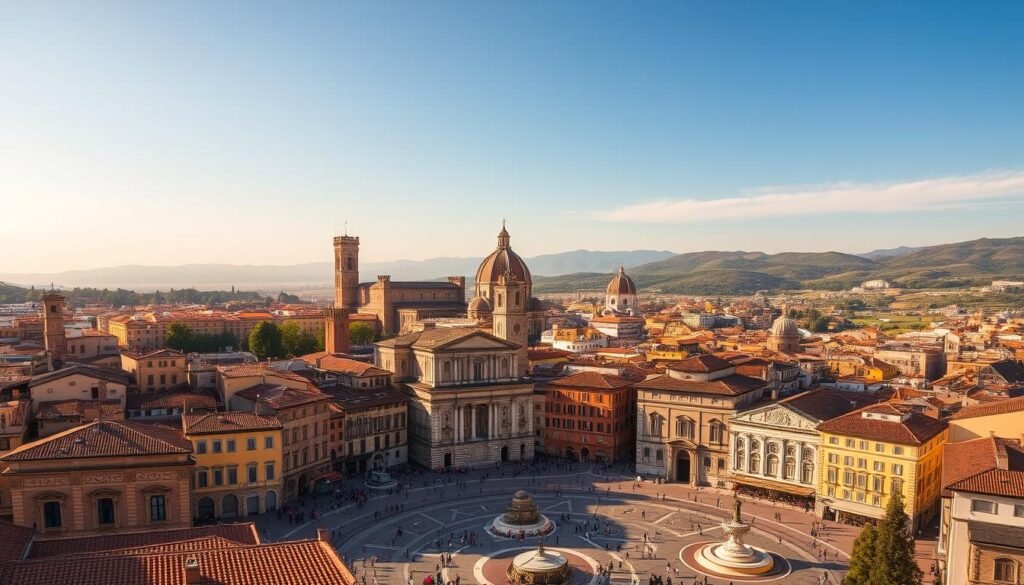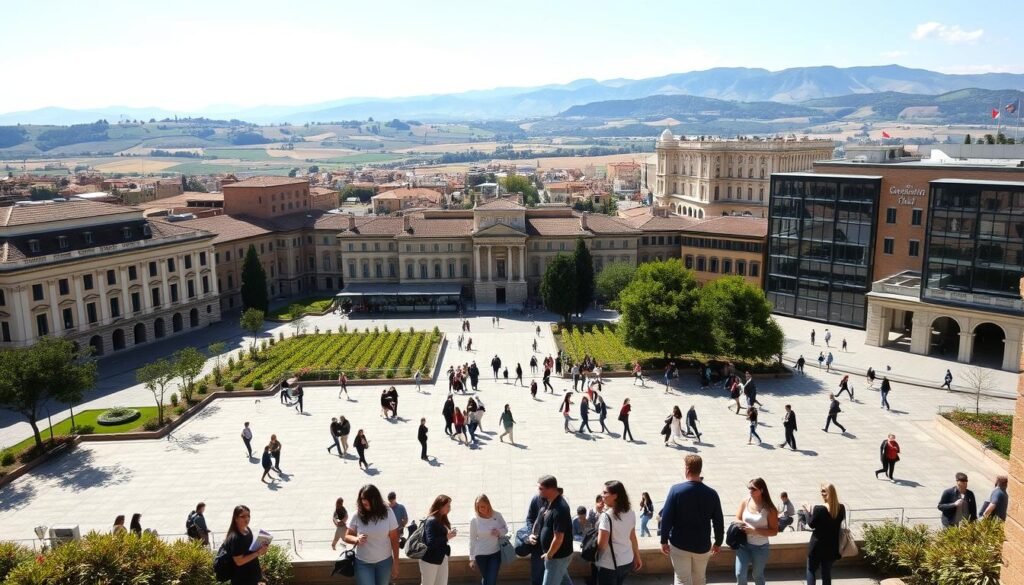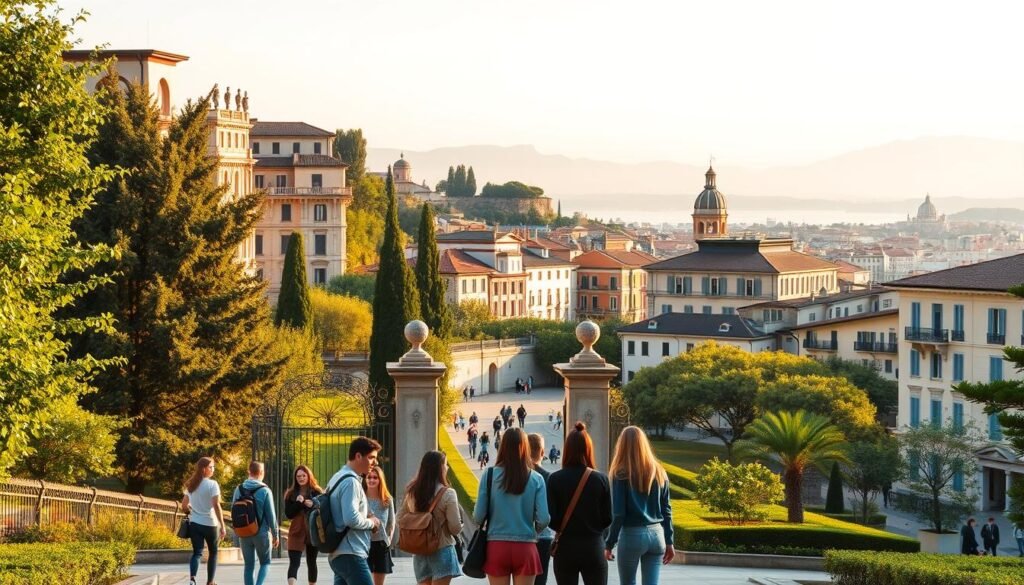Ever dreamed of immersing yourself in a country where history meets innovation? Italy offers an exceptional higher education experience, blending centuries-old academic traditions with cutting-edge research. From the snow-capped Dolomites to the sun-soaked Mediterranean coast, this country provides a stunning backdrop for learning.
With over 500 English-taught programs, Italy attracts students worldwide. Institutions like Tor Vergata University even offer income-based tuition, ranging from €150 to €5,000 per year. Beyond affordability, the country’s diverse regions—each with unique culture—create a vibrant student life.
Practical benefits, such as post-study work opportunities and streamlined visa processes, make it an appealing choice. Whether you’re drawn to art, engineering, or business, Italy’s universities provide world-class education in unforgettable settings.
Key Takeaways
- Italy combines historic prestige with modern academic excellence.
- Over 500 English-taught programs cater to international students.
- Tuition fees can be as low as €150/year at select universities.
- Diverse landscapes enrich the study abroad experience.
- Post-graduation work options add long-term value.
Why Study in Italy? A Land of History and Innovation
Few places blend ancient traditions with modern creativity like this European gem. Its universities have shaped thinkers for 900+ years, yet they lead in today’s global rankings.

Where Past and Future Collide
The country’s rich cultural heritage spans Roman engineering to Renaissance art. The University of Bologna, founded in 1088, still thrives as the world’s oldest degree-granting institution.
Italy’s Bologna Process standardized higher education across Europe. This ensures your degree is recognized worldwide.
Quality Education Without the Debt
Public universities average €1,000 per year—far cheaper than U.S. or U.K. schools. Some programs cost just €150 annually, thanks to income-based fees.
Compare this to Germany’s €3,000 or France’s €2,770 averages. The savings let you explore the country’s diverse regions.
More Than Just Classrooms
From Alpine ski towns to Sicilian beaches, each area offers unique climates and costs. Milan’s fashion hubs contrast with Florence’s art studios.
Authentic food culture bonds students, whether sharing pasta or espresso breaks. Festivals and local markets make daily life vibrant.
Top Universities in Italy for International Students
From medieval lecture halls to modern research labs, Italian universities offer a unique learning experience. Three institutions stand out for their global reputation, employability outcomes, and specialized programs.
![]()
University of Bologna: The World’s Oldest University
Founded in 1088, the University of Bologna pioneered Europe’s higher education standards. Its 935-year legacy continues with 11 schools offering 200+ degree programs.
Today, it ranks in the top 160 globally (QS rankings) for research in law and humanities. International students benefit from dual-degree partnerships across 32 countries.
University of Rome Tor Vergata: Excellence in Employability
This young but prestigious institution boasts a 94% graduate employment rate within six months. Its STEM programs, particularly engineering, are linked to Italy’s tech hubs.
Tor Vergata’s income-based tuition (€150–€5,000/year) makes it a top choice for budget-conscious students.
SDA Bocconi: Leading Business Education
Ranked #1 in Europe for MBAs, SDA Bocconi partners with 300+ corporations like Ferrari and IBM. Its finance specializations attract global talent.
Admission is competitive, requiring GMAT scores and interviews. However, graduates secure roles with average salaries of €85,000.
Study Programs Taught in English
Italy’s academic landscape offers a seamless blend of English-taught programs across diverse fields. Over 500 courses eliminate language barriers, making education accessible to global students.

Bachelor’s and Master’s Degrees Available
Leading institutions like Politecnico di Milano offer design bachelor degrees, while Istituto Marangoni excels in fashion. For advanced learners, master degrees in Renaissance Art Conservation blend theory with hands-on restoration.
Popular Fields: Fashion, Design, and Architecture
Fashion hubs like Milan provide internships with iconic brands. Architecture courses leverage Italy’s UNESCO sites, turning cities into classrooms. STEM fields are growing, with technical universities expanding English options.
EU students benefit from easy credit transfers, while others gain work experience through internships. Programs like Tor Vergata’s engineering degrees include corporate partnerships, boosting employability.
Tuition Fees and Cost of Living in Italy
Budgeting for higher education requires clear insights into tuition fees and daily expenses. Italy’s system balances affordability with quality, offering options for every financial plan.

Public vs. Private University Costs
Public universities average €1,000 annually, while private institutions range from €6,000 to €20,000. Engineering degrees often cost slightly more than humanities programs.
Regional variations exist—Milan’s rent averages €800/month, but Palermo drops to €300. Groceries at local mercatos cut food budgets by 30%.
Income-Based Fees at Tor Vergata
The University of Rome Tor Vergata calculates fees using the ISEE formula. Family income determines payments from €150 to €5,000 per year.
Required documents include tax returns and bank statements. This system ensures accessibility for low-income students.
Smart Saving Strategies
Student housing starts at €300/month, often including utilities. Shared apartments further reduce accommodation costs.
Use student discounts for trains (50% off) and museums (free entry). Cooking with seasonal ingredients keeps cost of living manageable.
Student Visa and Application Process
Navigating the visa process is simpler than you think when you have the right checklist. Italy’s streamlined system helps international students focus on academics, not paperwork.
Documents Needed to Apply
Start with an admission letter from your university. You’ll also need proof of funds (€467/month) and valid health insurance.
Academic transcripts must be notarized. Non-EU students should explore insurance plans like Sanità Integrativa, which meets visa requirements.
Step-by-Step Visa Guide
1. Collect documents (4–6 weeks before your embassy appointment).
2. Submit your application with a completed form and passport photos.
3. Attend the interview—typical approval rates exceed 85% for U.S. applicants.
Post-Study Work Opportunities
Graduates get a 1-year job search visa. Convert it to a work permit by securing employment. STEM fields offer the highest success rates.
Companies often sponsor visas for roles in tech, design, and finance. Start networking early through university career fairs.
Student Life in Italy: La Dolce Vita
Beyond textbooks, Italian student life blends learning with unforgettable experiences. From lively piazzas to centuries-old traditions, every moment immerses you in Italian culture.
Making Friends and Local Culture
Italians value warm greetings—offer a handshake or cheek kiss. Join university clubs like Erasmus Student Network to meet locals and international peers.
Dinner parties often start late. Bring wine or dessert as a guest. Shared meals strengthen bonds, whether in dorms or family-run trattorias.
Food, Festivals, and Travel
Try regional specialties: Milan’s ossobuco or Sicily’s cannoli. Universities host sagra (food fairs) where €5 buys full meals.
Plan trips around festivals like Venice Carnival (February) or Siena’s Palio (July). Trenitalia’s €29 regional passes make weekend getaways affordable.
Learning Italian for Daily Life
70% of Italians speak only their native language outside cities. Enroll in language learning courses—many universities offer free CILS certification prep.
Practice at markets by asking for “quanto costa?” (how much?). Even basics like grazie (thank you) earn smiles.
Conclusion: Start Your Italian Education Journey
Ready to transform your future with world-class universities and vibrant experiences? Italy combines affordable tuition, rich culture, and strong career pathways. Use our shortlisting tools to match with programs that fit your goals.
Fall intake deadlines close soon—submit applications by July for most scholarships, including MAECI awards. Need a checklist? Gather transcripts, recommendation letters, and proof of funds.
Apply now to secure your spot. From historic lecture halls to cutting-edge labs, your education in Italy begins here.
FAQ
What are the best universities in Italy for international students?
The University of Bologna, the world’s oldest, offers a historic yet modern education. Tor Vergata in Rome excels in employability, while SDA Bocconi is a top choice for business programs.
Are there English-taught programs available?
Yes! Over 500 programs are taught in English, including bachelor’s and master’s degrees in fashion, design, art, and architecture.
How much does it cost to study in Italy?
Public universities charge lower fees, often based on income. Private institutions cost more. Living expenses vary, but smart budgeting helps with accommodation and food.
What documents are needed for a student visa?
You’ll need an acceptance letter, proof of finances, health insurance, and a valid passport. Check Italy’s consulate website for the latest requirements.
Can I work after graduation?
Yes! Italy offers post-study work opportunities. Many graduates find jobs in fashion, design, and business sectors.
Is learning Italian necessary?
While many programs are in English, knowing Italian helps with daily life, making friends, and immersing in local culture.
What’s student life like in Italy?
Expect vibrant festivals, delicious food, and travel opportunities. Universities also host events to help you connect with peers.






